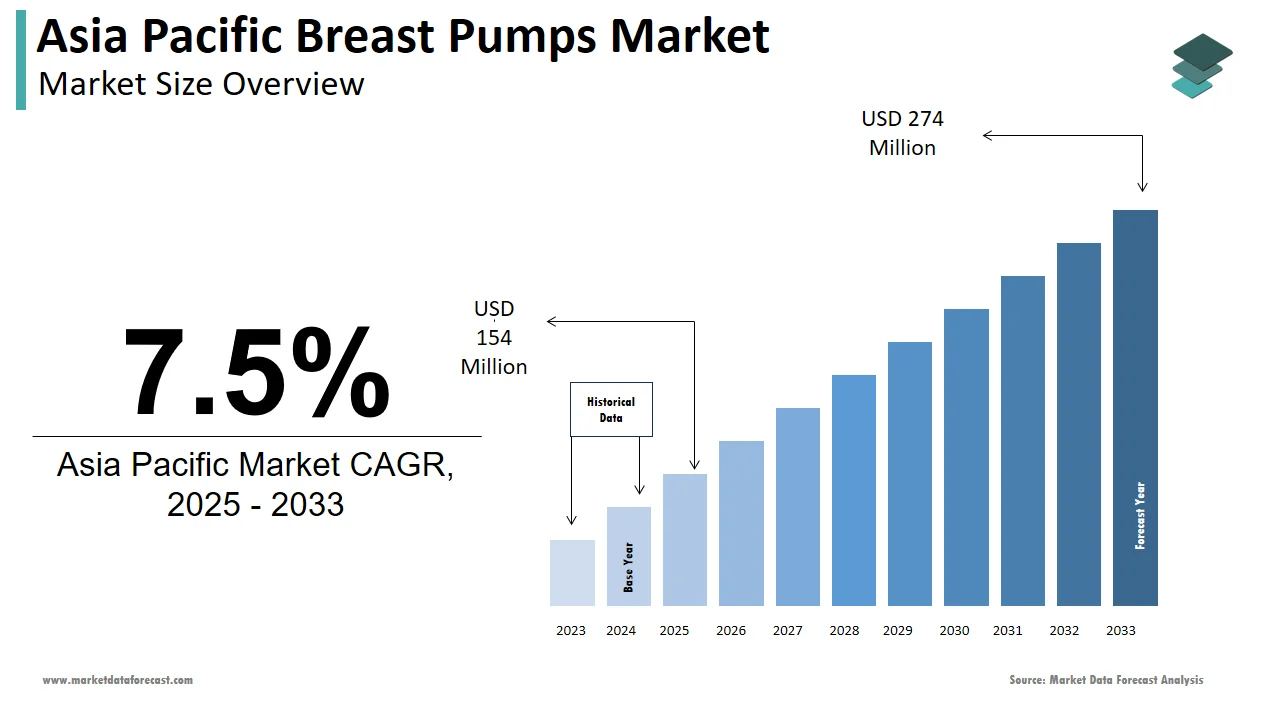Asia Pacific Breast Pumps Market Size, Share, Trends & Growth Forecast Report By Product Type, Application, Technology & Country (India, China, Japan, South Korea, Australia, New Zealand, Thailand, Malaysia, Vietnam, Philippines, Indonesia, Singapore & Rest of APAC) - Industry Analysis From (2025 to 2033)
Asia Pacific Breast Pumps Market Size
The size of the Asia Pacific breast pumps market was valued at USD 143 million in 2024. This market is expected to grow at a CAGR of 7.5% from 2025 to 2033 and be worth USD 274 million by 2033 from USD 154 million in 2025.
MARKET DRIVERS
Rising Employment of Women and Healthcare Investments Drive Breast Pumps Market Growth
The hectic lifestyle of today's working mothers necessitates specialized medical equipment known as breast pumps. The growing employment rate of women is the primary driver behind the progress of technology in the healthcare sector. These technologies can isolate and collect breast milk while preserving its nutritional content. It allows the mother to collect milk while at work and then breastfeed the baby with the milk preserved in bottles. Breast pumps are more popular and are becoming important medical equipment. Other factors driving the market growth are the increase in the number of milk banks, market players, and the government taking initiatives to improve and invest more in developing healthcare infrastructure.
Government Initiatives and Technological Advancements Boost Breast Pumps Market Demand
The various governments across the region are taking initiatives to create awareness among women about the benefits and importance of breastfeeding to the baby, which positively influences the demand for market growth. In addition, technological advancements in the design and effectiveness of breast pumps are another prominent factor boosting the adoption. For instance, the introduction of double pumping 2-phase expression technology supports market growth. These devices are likely to extract and collect breast milk while preserving its nutritional value. It enables the mother to collect milk while at work and then breastfeed the baby using milk stored in bottles. Moreover, the benefits include reducing time and providing maximum comfort; therefore, the technology makes the women shift from breastfeeding and pumping.
MARKET RESTRAINTS
High Costs and Regulatory Barriers Restrain the Breast Pumps Market Growth
The availability of breast milk replacements, the high cost associated with the breast pump, problems related to fertility, and lack of awareness are the factors negatively impacting the market growth. Also, some developing and underdeveloped countries are still struggling with women's employment rates and getting newer technologies. Therefore, the breast pumps are yet to fully enter and generate demand in those markets. In addition, government policies criminalize breast pumps in some areas like Australia, restricting the market’s growth.
REPORT COVERAGE
|
REPORT METRIC |
DETAILS |
|
Market Size Available |
2024 to 2033 |
|
Base Year |
2024 |
|
Forecast Period |
2025 to 2033 |
|
Segments Covered |
By Product Type, Application, and Region. |
|
Various Analyses Covered |
Global, Regional and Country-Level Analysis, Segment-Level Analysis, Drivers, Restraints, Opportunities, Challenges; PESTLE Analysis; Porter’s Five Forces Analysis, Competitive Landscape, Analyst Overview of Investment Opportunities |
|
Countries Covered |
India, China, Japan, South Korea, Australia, New Zealand, Thailand, Malaysia, Vietnam, Philippines, Indonesia, Singapore, Rest Of APAC. |
|
Market Leaders Profiled |
Pigeon Group (Pigeon Corporation), Koninklijke Philips N.V., Ameda, Inc., Ardo Medical Ag, Evenflo Feeding, Inc. Other players in the market are Mayborn Group Limited (Shanghai Jahwa Co. Ltd), Spectra Baby USA, Albert Manufacturing USA (Albert Group), Hygeia Health, and others. |
COUNTRY LEVEL ANALYSIS

Regionally, the Asia Pacific is the fastest-growing market and is likely to continue its growth streak in the forecast period. Moreover, in the sector of mechanical medical devices, the Indian breast pumps market is emerging as one of the fastest-growing markets during the forecast period. With the world's second-largest economy, the China breast pumps market is anticipated to reach a market size of USD 205.34 million by 2033, representing a 5% CAGR during the forecast period. However, selling human items like breast pumps is illegal in Australia, making establishing a formal milk bank system. So today, there are only five banks in Australia, and only one distributes milk to the general population.
KEY MARKET PLAYERS
Companies playing a significant role in the Asia Pacific Breast pumps market profiled in this report are Pigeon Group (Pigeon Corporation), Koninklijke Philips N.V., Ameda, Inc., Ardo Medical Ag, Evenflo Feeding, Inc. Other players in the market are Mayborn Group Limited (Shanghai Jahwa Co. Ltd), Spectra Baby USA, Albert Manufacturing USA (Albert Group), Hygeia Health, and others.
MARKET SEGMENTATION
This Asia Pacific breast pumps market research report is segmented and sub-segmented into the following categories.
By Product Type
- Closed
- Open
By Application
- Personal Use Pumps
- Healthcare/hospital Grade Pumps
By Technology
- Battery Powered
- Manual
- Electric
By Country
- India
- China
- Japan
- South Korea
- Australia
- New Zealand
- Thailand
- Malaysia
- Vietnam
- Philippines
- Indonesia
- Singapore
- Rest Of APAC
Related Reports
Access the study in MULTIPLE FORMATS
Purchase options starting from $ 2000
Didn’t find what you’re looking for?
TALK TO OUR ANALYST TEAM
Need something within your budget?
NO WORRIES! WE GOT YOU COVERED!
Call us on: +1 888 702 9696 (U.S Toll Free)
Write to us: sales@marketdataforecast.com

